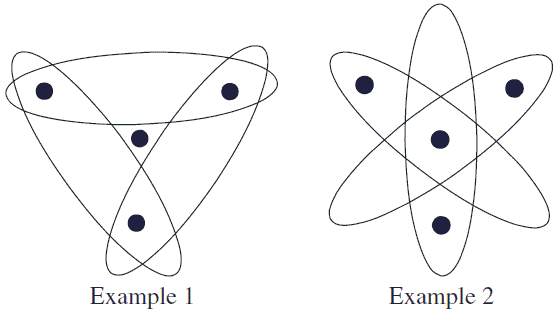Mutually (Jointly) Independent Events
Two events A and B are independent iff P(A∩B) = P(A)P(B). This definition extends to the notion of independence of a finite number of events. Let K be a finite set of indices. Events Ak, k∈K are said to be mutually (or jointly) independent iff
| P(∩m∈MAm) = Πm∈MP(Am), |
for any subset M⊂K. For example, for four events A, B, C, D to be mutually independent, we must have
|
P(A∩B∩C∩D) = P(A)P(B)P(C)P(D), P(A∩B∩C) = P(A)P(B)P(C), P(A∩B∩D) = P(A)P(B)P(D), P(A∩C∩D) = P(A)P(C)P(D), P(B∩C∩D) = P(B)P(C)P(D), P(A∩B) = P(A)P(B), P(A∩C) = P(A)P(C), P(A∩D) = P(A)P(D), P(B∩C) = P(B)P(C), P(B∩D) = P(B)P(D), P(C∩D) = P(C)P(D). |
Thus, by the definitions, mutual independence implies the pairwise independence. For two events, the definitions actually coincide. For more than two events, they are not. There are pairwise independent events that are not mutually independent. Two examples have been produced by S. N. Bernstein years ago and discussed more recently (2007) by C. Stepniak.
Consider an urn containing four balls, numbered 110, 101, 011 and 000, from which one ball is drawn at random. For
For a second example, let Bk be the event of drawing a ball with 0 in position k. Now, for
The two examples are essentially different because in the first the intersection of A's is empty whereas in the second the intersection of B's is not.

Noting this, Stepniak proceeds to prove that Bernstein's are the only possible examples in a space with four outcomes. Thus assume that three (pairwise) independent events A, B, C are defined in the space with four outcomes, none being the whole of the space. None may consist of a single outcome. For assume
There are just two possibilities. There is an outcome common to all three events, which gives the configuration of the second example. Or there is no outcome common to all events, which gives the configuration of the first example.
References
- S. N. Bernstein, Theory of Probability, 4th ed. (in Russian), Gostechizdat, Moscow-Leningrad, 1946. (in Russian)
- C. Stepniak, Bernstein's Examples on Independent Events, The College Mathematics Journal, VOL. 38, NO. 2, MARCH 2007, 140-142
- What Is Probability?
- Intuitive Probability
- Probability Problems
- Sample Spaces and Random Variables
- Probabilities
- Conditional Probability
- Dependent and Independent Events
- Algebra of Random Variables
- Expectation
- Probability Generating Functions
- Probability of Two Integers Being Coprime
- Random Walks
- Probabilistic Method
- Probability Paradoxes
- Symmetry Principle in Probability
- Non-transitive Dice
|Contact| |Front page| |Contents| |Up|
Copyright © `996-2010 Alexander Bogomolny
73580552
